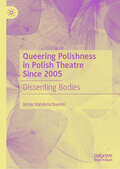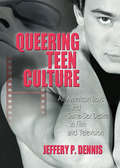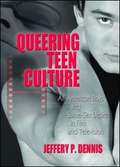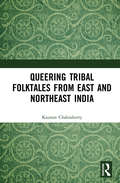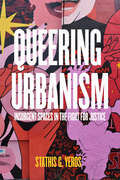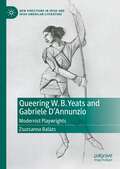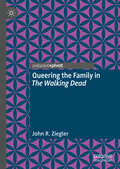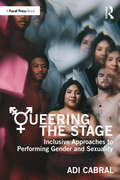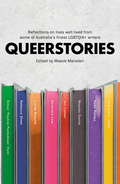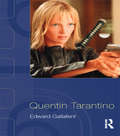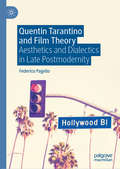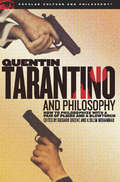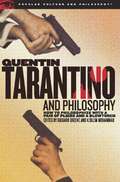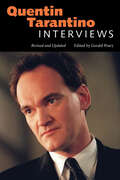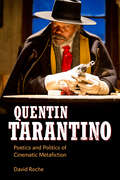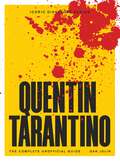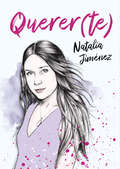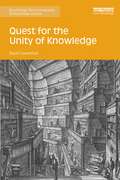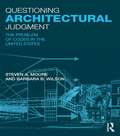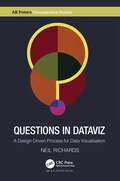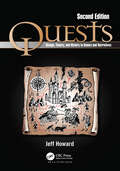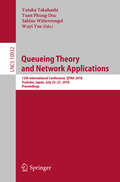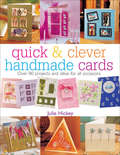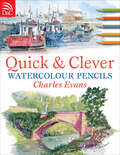- Table View
- List View
Queering Polishness in Polish Theatre Since 2005: Dissenting Bodies
by Jonas VanderschuerenTheatre has long been an art form at the centre of public life in Poland. Whether it is the self-professed poet-prophets of the Romantic era, or the dissident theatre makers working under the strictures of state socialism, the art form has played a vital role in the development of Polish culture and politics in the context of shifting foreign occupations. This book explores the relationship between contemporary Polish theatre makers and contemporary notions of Polishness and argues that queer theory, and specifically a Polish appropriation of queer theory, can be a crucial element to better understand the politicality of the contemporary Polish theatre field. It does this by focusing on critical theatre productions which are produced at the margins of the Polish theatre field, a choice which has been made as the field is dominated by traditional drama theatres which reproduce a Polish variation on the Western canon. This makes smaller, atypical, and independent theatre productions all the more significant, as they signify a refusal to continue the traditional role of the Polish theatre field in reproducing the canon of Polish Romanticism. As such, the book argues that contemporary Polish theatre has been marked by a struggle between those building performances and state authorities that see those creations as a threat to their authority.
Queering Teen Culture: All-American Boys and Same-Sex Desire in Film and Television
by Jeffery P DennisWhy did Fonzie hang around with all those high school boys?Is the overwhelming boy-meets-girl content of popular teen movies, music, books, and TV just a cover for an undercurrent of same-sex desire? From the 1950s to the present, popular culture has involved teenage boys falling for, longing over, dreaming about, singing to, and fighting over, teenage girls. But Queering Teen Culture analyzes more than 200 movies and TV shows to uncover who Frankie Avalon&’s character was really in love with in those beach movies and why Leif Garrett became a teen idol in the 1970s. In Top 40 songs, teen magazines, movies, TV soap operas and sitcoms, teenagers are defined by their pubescent "discovery" of the opposite sex, universally and without exception. Queering Teen Culture looks beyond the litany to find out when adults became so insistent about teenage sexual desire-and why-and finds evidence of same-sex desire, romantic interactions, and identities that, according to the dominant ideology, do not and cannot exist. This provocative book examines the careers of male performers whose teenage roles made them famous (including Ricky Nelson, Pat Boone, Fabian, and James Darren) and discusses examples of lesbian desire (including I Love Lucy and Laverne and Shirley). Queering Teen Culture examines: Ozzie and Harriet, Father Knows Best, and Leave It to Beaver: Were Ricky, Bud, and Wally sufficiently straight? the juvenile delinquent films of the 1950s: Why weren&’t the rebel-without-a-cause "bad boys" interested in girls? horror, sci-fi, and zombies from outer space: "Body of a boy! Mind of a monster! Soul of an unearthly thing!" teen idols-pretty, androgynous, and feminine: No wonder they were rumored to be "funny" beach movies: She wants to plan their wedding but he wants to surf, sky-dive and go drag racing with the guys Biker-hippies boys of the late 1960s: "I know your scene-don&’t think I don&’t!" the 1950s nostalgia of the 1970s: Why does Fonzie spend all his time with high school boys? teen gore: What makes the psycho-killer angry? and much more, including Gidget, the Brat Pack, buddy dramas, nerds and "operators," Saved by the Bell, The Real World, and the incredible shrinking teenager Queering Teen Culture is an essential read for academics working in cultural and gay studies, and for anyone else with an interest in popular culture.
Queering Teen Culture: All-American Boys and Same-Sex Desire in Film and Television
by Jeffrey P. DennisExamines text and subtext in relationships between male characters in t.v. and film from the 1950s through the present.
Queering Tribal Folktales from East and Northeast India
by Kaustav ChakrabortyThis book explores queer potentialities in the tribal folktales of India. It elucidates the queer elements in the oral narratives of four indigenous communities from East and Northeast India, which are found to be significant repositories of gender fluidity and non-normative desires. Departing from the popular understanding that ‘Otherness’ results largely from undue exposure to Western permissiveness, the author reveals how minority sexualities actually have their roots in aboriginal indigenous cultures and do not necessarily constitute a mimicry of the West. The volume endeavours to demystify the politics behind such vindictive propagation to sensitize the queerphobic mainstream about the essential endogenous presence of the queer in the spaces that are aboriginal. Based on extensive interdisciplinary research, this book is a first of its kind in the study of indigenous queer narratives. It will be useful to scholars and researchers of queer studies, gender studies, tribal and indigenous studies, literature, cultural studies, postcolonialism, sociology, political studies and South Asian studies.
Queering Urbanism: Insurgent Spaces in the Fight for Justice
by Stathis G. YerosA free ebook version of this title is available through Luminos, University of California Press’s Open Access publishing program. Visit www.luminosoa.org to learn more. Conflicts about space and access to resources have shaped queer histories from at least 1965 to the present. As spaces associated with middle-class homosexuality enter mainstream urbanity in the United States, cultural assimilation increasingly erases insurgent aspects of these social movements. This gentrification itself leads to queer displacement. Combining urban history, architectural critique, and queer and trans theories, Queering Urbanism traces these phenomena through the history of a network of sites in the San Francisco Bay Area. Within that urban landscape, Stathis Yeros investigates how queer people appropriated existing spaces, how they expressed their distinct identities through aesthetic forms, and why they mobilized the language of citizenship to shape place and secure space. Here the legacies of LGBTQ+ rights activism meet contemporary debates about the right to housing and urban life.
Queering W. B. Yeats and Gabriele D’Annunzio: Modernist Playwrights (New Directions in Irish and Irish American Literature)
by Zsuzsanna BalázsQueering W. B. Yeats and Gabriele D’Annunzio: Modernist Playwrights challenges the general resistance in scholarship and queer studies to approach Yeats and D’Annunzio through a queer lens because of their controversial affiliations with fascism and elitism, their heterosexuality and their venerated canonical status. This book provides the first fully theorised queer and comparative reading of Yeats’s and D’Annunzio’s drama. It offers the novel contention that due to their increasing involvement in queer and feminist subcultures, their plays feature feelings that are associated with queer historiography and generate ideas that began to be theorised by queer studies more than half a century after the composition of the plays. Moreover, it uncovers an alert, subversive and often coded social commentary in eight key dramatic texts by each playwright and at the same time highlights the thus far neglected commonalities between the plays and the queer historical as well as cultural contexts of these two prominent modernists.
Queering the Family in The Walking Dead
by John R. ZieglerThis book traces how The Walking Dead franchise narratively, visually, and rhetorically represents transgressions against heteronormativity and the nuclear family. The introduction argues that The Walking Dead reflects cultural anxiety over threats to the family. Chapter 1 examines the destructive competition created by heteronormativity, such as the conflict between Rick and Shane. Chapter 2 focuses on the actual or attempted participation of characters such as Carol and Negan in queer relationships. Chapter 3 interprets zombies as queer antagonists to heteronormativity, while Chapter 4 explores the incorporation of zombies into the lives of characters such as the Governor and the Whisperers. The conclusion asserts that The Walking Dead presents both queer alternatives to and damaging contradictions within the traditional heterosexual family model, helping to question this model and to consider the struggle of queer American families. Overall, this study holds special interest for students and scholars of queerness, zombies, and the family.
Queering the Stage: Inclusive Approaches to Performing Gender and Sexuality
by Adi CabralQueering the Stage: Inclusive Approaches to Performing Gender and Sexuality addresses a history of stereotyping and provides inclusive approaches to navigating gender and sexuality in a way that does not reduce the broad spectrum of LGBTQ+ communities into a single monolith.Butch it up! Be more manly! Add a little swish! Queen out! These instructions make performers feel minimized, erased, and forced to fit in a binary that encourages underdeveloped portrayals of queer identities. This book will guide the reader in performance techniques for confidently embodying the masculine/ feminine, gay/ straight binaries – as concepts of chosen choreography rather than reductive prescriptions – while also providing non- binary exercises to explore and expand the use of the body, voice, heart, and mind to bring life to characters of sexual orientations and gender identities that do and do not align with the actors’ lived experiences. The reader will be presented with multiple tools for analyzing, developing, and embodying a diverse array of characters, empowering them to make their own choices when it comes to performance. While there is no “right” way to teach performance, this book will present tools rooted in trauma- informed practices that aim to prevent and undo harm in a group setting with a facilitator, or individually.This book is written for instructors of theatre performance and acting wishing to expand their curriculum to include queer concepts in their classroom, and actors working in the industry who want to improve their ability performing characters of diverse genders and sexualities.A companion website, available at www.adicabral.com/queering-the-stage, provides additional materials to support exercises given throughout the book.
Queerstories: Reflections on lives well lived from some of Australia's finest LGBTQIA+ writers
by Maeve MarsdenThere's more to being queer than coming out and getting married. This exciting and contemporary collection contains stories that are as diverse as the LGBTQIA+ community from which they're drawn. From hilarious anecdotes of an awkward adolescence, to heartwarming stories of family acceptance and self-discovery, the LGBTQIA+ community has been sharing stories for centuries, creating their own histories, disrupting and reinventing conventional ideas about narrative, family, love and community.Curated from the hugely popular Queerstories storytelling event this important collection features stories from Benjamin Law, Jen Cloher, Nayuka Gorrie, Peter Polites, Candy Royalle, Rebecca Shaw, Simon 'Pauline Pantsdown' Hunt, Steven Lindsay Ross, Amy Coopes, Paul van Reyk, Mama Alto, Liz Duck-Chong, Maxine Kauter, David Cunningham, Peter Taggart, Ben McLeay, Jax Jacki Brown, Ginger Valentine, Candy Bowers, Simon Copland, Kelly Azizi, Nic Holas, Quinn Eades, Vicki Melson, Tim Bishop and Maeve Marsden.
Quentin Tarantino
by Edward GallafentQuentin Tarantino is one of the best-known living American filmmakers in the world, and the story of his career has been the subject of a number of books and articles. But what do his films mean? In this new study, Edward Gallafent does not look at Tarantino’s story but at the films themselves. He asks to what extent Tarantino can be seen as a specifically American filmmaker, with the kinds of preoccupations and interests that have formed part of Hollywood’s traditions, and also how he explores the expressive possibilities of current cinema. The book concentrates on the main feature films of Tarantino’s career so far: Reservoir Dogs, Pulp Fiction, Jackie Brown, and the two volumes of Kill Bill. Apart from Kill Bill the films are not treated individually, but in terms of some of the subjects that connect them together, such as success and tradition, their notorious deployment of violence, and Tarantino’s approach to story-telling: his interest in presenting events out of chronological order. The book also covers adaptations of Tarantino’s work, looking at the screenplays of True Romance and Natural Born Killers as well as the films made from them, and compares Tarantino’s approach to adapting Elmore Leonard with that of another important American filmmaker, Paul Schrader. The aim of the book is to explore these topics and to take the reader back to what the American critic Robert Warshow called the ‘actual, immediate experience of seeing and responding to the movies’. It is designed to appeal both to those who were excited by the films on first seeing them in the cinema and to those taking the opportunity of reconsidering them on the screen or on DVD.
Quentin Tarantino and Film Theory: Aesthetics and Dialectics in Late Postmodernity
by Federico PagelloThis book examines a set of theoretical perspectives that critically engage with the notion of postmodernism, investigating whether this concept is still useful to approach contemporary cinema. This question is explored through a discussion of the films written and directed by Quentin Tarantino, largely regarded as the epitome of postmodern cinema and considered here as theoretical contributions in their own right. Each chapter first presents key ideas proposed by a specific theorist and then puts them in conversation with Tarantino’s films. Jacques Rancière’s theory of art is used to reject postmodernism’s claims about the ‘death’ of the aesthetic image in contemporary cinema. Fredric Jameson’s and Slavoj Žižek’s dialectical thinking is mobilized to challenge simplistic, ideological readings of postmodern cinema in general, and Tarantino’s films in particular. Finally, the direct influence of Carol Clover’s psychoanalytical approach to the horror genre on Tarantino’s work is discussed to prove the director’s specific contribution to a theoretical understanding of contemporary film aesthetics.
Quentin Tarantino and Philosophy
by Richard Greene K. Silem MohammadThe films of Quentin Tarantino are ripe for philosophical speculation, raising compelling questions about justice and ethics, violence and aggression, the nature of causality, and the flow of time. In this witty collection of articles, no subject is too taboo for the writers to tackle. From an aesthetic meditation on the use of spraying blood in Kill Bill to the conundrum of translation and reference in Vincent and Jules' discussion about French Big Macs in Pulp Fiction, Tarantino and Philosophy shies away from nothing. Is The Bride a heroic figure, even though she's motivated solely by revenge? How is Tarantino able to create a coherent story when he jumps between past, future, and present? The philosophers in this book take on those questions and more in essays as provocative as the films themselves.
Quentin Tarantino and Philosophy: How to Philosophize with a Pair of Pliers and a Blowtorch
by Richard Greene K. Silem MohammadFifteen essays presented by Greene (philosophy, Weber State U) and Mohammad (language, literature, and philosophy, Southern Oregon U) explore a range of philosophical questions through engagements with the films of director Quentin Tarantino. Topics include a Nietzschean reading of Reservoir Dogs, the ethics of revenge and mercy and the recitation of the biblical passage Ezekiel 25:17 in Pulp Fiction, the ethics of vengeance in Kill Bill, knowledge and pragmatism in Jackie Brown, transformations of time and causality in Pulp Fiction, Kill Bill as Oedipal play, and elements of Buddhist philosophy in Kill Bill.
Quentin Tarantino: Interviews, Revised and Updated (Conversations with Filmmakers Series)
by Gerald PearyHere, in his own colorful, slangy words, is the true American Dream saga of a self-proclaimed "film geek," with five intense years working in a video store, who became one of the most popular, recognizable, and imitated of all filmmakers. His dazzling, movie-informed work makes Quentin Tarantino's reputation, from his breakout film, Reservoir Dogs (1992), through Kill Bill: Vol. 1 (2003) and Kill Bill: Vol. 2 (2004), his enchanted homages to Asian action cinema, to his rousing tribute to guys-on-a-mission World War II movie, Inglourious Basterds (2009). For those who prefer a more mature, contemplative cinema, Tarantino provided the tender, very touching Jackie Brown (1997). A masterpiece--Pulp Fiction (1994). A delightful mash of unabashed exploitation and felt social consciousness--his latest opus, Django Unchained (2012).From the beginning, Tarantino (b. 1963)--affable, open, and enthusiastic about sharing his adoration of movies--has been a journalist's dream. Quentin Tarantino: Interviews, revised and updated with twelve new interviews, is a joy to read cover to cover because its subject has so much interesting and provocative to say about his own movies and about cinema in general, and also about his unusual life. He is frank and revealing about growing up in Los Angeles with a single, half-Cherokee mother, and dropping out of ninth grade to take acting classes. Lost and confused, he still managed a gutsy ambition: young Quentin decided he would be a filmmaker.Tarantino has conceded that Ordell (Samuel L. Jackson), the homicidal African American con man in Jackie Brown, is an autobiographical portrait. "If I hadn't wanted to make movies, I would have ended up as Ordell," Tarantino has explained. "I wouldn't have been a postman or worked at the phone company. . . . I would have gone to jail."
Quentin Tarantino: Poetics and Politics of Cinematic Metafiction
by David RocheQuentin Tarantino’s films beg to be considered metafiction: metacommentaries that engage with the history of cultural representations and exalt the aesthetic, ethical, and political potential of creation as re-re-creation and resignification. Covering all eight of Quentin Tarantino’s films according to certain themes, David Roche combines cultural studies and neoformalist approaches to highlight how closely the films’ poetics and politics are intertwined. Each in-depth chapter focuses on a salient feature, some which have drawn much attention (history, race, gender, violence), others less so (narrative structure, style, music, theatricality).Roche sets Tarantino’s films firmly in the legacy of Howard Hawks, Jean-Luc Godard, Sergio Leone, and the New Hollywood, revising the image of a cool pop-culture purveyor that the American director cultivated at the beginning of his career. Roche emphasizes the breadth and depth of his films’ engagement with culture, highbrow and lowbrow, screen and print, American, East Asian, and European.
Quentin Tarantino: The Complete Unofficial Guide (Iconic Directors)
by Dan JolinQuentin Tarantino is one of the most iconic and best loved movie directors of the last two decades. Whether he's shooting up the Deep South, slicing through the Japanese underworld, blasting Nazi-occupied France or taking a flamethrower to '60s Los Angeles, Tarantino is a director who combines a radical vision with a sense of history: making movies precisely the way he wants, to celebrate the movies he loves. Featuring insights into his inspirations - from martial-arts epics to Spaghetti Westerns - and dishing up fascinating details from his productions, this is an indispensable guide to Tarantino's thrilling and sometimes controversial body of work.It takes in his searing debut Reservoir Dogs, the era-defining Pulp Fiction and the genre-subverting Django Unchained, among other modern classics, right up to his nostalgic masterpiece Once Upon A Time in Hollywood. Above all, this is a celebration of a filmmaker who has arguably made a bigger impact on modern pop culture than any other.
Quentin Tarantino: The Complete Unofficial Guide (Iconic Directors)
by Dan JolinQuentin Tarantino is one of the most iconic and best loved movie directors of the last two decades. Whether he's shooting up the Deep South, slicing through the Japanese underworld, blasting Nazi-occupied France or taking a flamethrower to '60s Los Angeles, Tarantino is a director who combines a radical vision with a sense of history: making movies precisely the way he wants, to celebrate the movies he loves. Featuring insights into his inspirations - from martial-arts epics to Spaghetti Westerns - and dishing up fascinating details from his productions, this is an indispensable guide to Tarantino's thrilling and sometimes controversial body of work.It takes in his searing debut Reservoir Dogs, the era-defining Pulp Fiction and the genre-subverting Django Unchained, among other modern classics, right up to his nostalgic masterpiece Once Upon A Time in Hollywood. Above all, this is a celebration of a filmmaker who has arguably made a bigger impact on modern pop culture than any other.
Querer(te)
by Natalia JiménezEl primer libro de Natalia Jiménez. Una conmovedora historia de superación que puede inspirar a much@s niñ@s. «Quiero dejar el miedo atrás y compartir mi experiencia con la esperanza de que la lectura de este libro pueda llegar a ayudar a alguien. »Quiero que veáis que a veces lo "bueno" también puede traer consecuencias inesperadas y que muchas veces luchas contra ti mismo cuando tienes un problema, en vez de admitir que lo hay. »Voy a contar una historia que NADIE sabía hasta este momento. Algo que no podrías imaginar que te puede pasar cuando acabas de cumplir uno de tus sueños. »Pero también quiero compartir todo lo que he aprendido, y todo lo que he pasado hasta llegar a ser como soy, y a aceptarme y quererme de este modo.»Natalia Jiménez
Quest for the Unity of Knowledge (Routledge Environmental Humanities)
by David LowenthalIs unity of knowledge possible? Is it desirable? Two rival visions clash. One seeks a single way of explaining everything known and knowable about ourselves and the universe. The other champions diverse modes of understanding served by disparate kinds of evidence. Contrary views pit science against the arts and humanities. Scientists generally laud and seek convergence. Artists and humanists deplore amalgamation as a threat to humane values. These opposing perspectives flamed into hostility in the 1950s "Two Cultures" clash. They culminate today in new efforts to conjoin insights into physical nature and human culture, and new fears lest such syntheses submerge what the arts and humanities most value. This book, stemming from David Lowenthal’s inaugural Stockholm Archipelago Lectures, explores the Two Cultures quarrel’s underlying ideologies. Lowenthal shows how ingrained bias toward unity or diversity shapes major issues in education, religion, genetics, race relations, heritage governance, and environmental policy. Aimed at a general academic audience, Quest for the Unity of Knowledge especially targets those in conservation, ecology, history of ideas, museology, and heritage studies.
Questioning Architectural Judgment: The Problem of Codes in the United States
by Steven A. Moore Barbara B. WilsonThe book shines light on the problem of judgment, particularly in the realm of architectural "technics" and the codes that regulate it. The struggle to define "sustainability," and thus judge architecture through such lenses, is but one dimension of the contemporary problem of judgment. By providing the reader with an inherently interdisciplinary study of a particular discipline—architecture, it brings to the topic lenses that challenge the too frequently unexamined assumptions of the discipline. By situating architecture within a broader cultural field and using case studies to dissect the issues discussed, the book emphasizes that it is not simply a matter of designing better, more efficient, or more stringent codes to guide place-making, but a matter of reconstructing the boundaries of the systems to be coded. The authors are winners of the EDRA Place-Research Award 2014 for their work on the Green Alley Demonstration Project used in the book.
Questions in Dataviz: A Design-Driven Process for Data Visualisation (AK Peters Visualization Series)
by Neil RichardsThis book takes the reader through the process of learning and creating data visualisation, following a unique journey with questions every step of the way, ultimately discussing how and when to bend and break the "rules" to come up with creative, unique, and sometimes unconventional ideas. Each easy-to-follow chapter poses one key question and provides a selection of discussion points and relevant data visualisation examples throughout. Structured in three parts: Section I poses questions around some fundamental data visualisation principles, while Section II introduces more advanced questions, challenging perceived best practices and suggesting when rules are open to interpretation or there to be broken. The questions in Section III introduce further themes leading on to specific ideas and visualisation projects in more detail. Questions in Dataviz: A Design-Driven Process for Data Visualisation will appeal to any reader with an interest in creative or unconventional data visualisation and will be especially useful for those at a beginner or intermediate level looking for inspiration and alternative ways to deploy their data visualisation skills outside of conventional business charts.
Quests: Design, Theory, and History in Games and Narratives
by Jeff HowardCombining theory and practice, this updated new edition provides a complete overview of how to create deep and meaningful quests for games. It uses the Unity game engine in conjunction with Fungus and other free plugins to provide an accessible entry into quest design. The book begins with an introduction to the theory and history of quests in games, before covering four theoretical components of quests: their spaces, objects, actors, and challenges. Each chapter also includes a practical section, with accompanying exercises and suggestions for the use of specific technologies for four crucial aspects of quest design: • level design • quest item creation • NPC and dialogue construction • scripting This book will be of great interest to all game designers looking to create new, innovative quests in their games. It will also appeal to new media researchers, as well as humanities scholars in the fields of mythology and depth-psychology that want to bring computer-assisted instruction into their classroom in an innovative way. The companion website includes lecture and workshop slides, and can be accessed at: www.designingquests.com
Queueing Theory and Network Applications: 13th International Conference, QTNA 2018, Tsukuba, Japan, July 25-27, 2018, Proceedings (Lecture Notes in Computer Science #10932)
by Yutaka Takahashi Wuyi Yue Sabine Wittevrongel Tuan Phung-DucThis book constitutes the proceedings of the 13th International Conference on Queueing Theory and Network Applications, QTNA 2018, held in Tsukuba, Japan in July 2018.The 8 full papers together with 10 short papers included in this volume were carefully reviewed and selected from 57 initial submissions. All the papers to be presented disseminate the latest results covering up-to-date research fields such as performance modeling and analysis of telecommunication systems, retrial and vacation queueing models, optimization of queueing systems, modeling of social systems, application of machine learning in queueing models.
Quick & Clever Handmade Cards: Over 80 Projects and Ideas for All Occasions
by Julie HickeyWeddings, Birthdays, Christmas, Get Well, Good Luck and more: the variety of occasions on which a handmade card would be appreciated is endless! This book offers such a huge variety of fast and easy-to-complete design ideas that you will be spoilt for choice when deciding what to make. Ideas for making matching envelopes, inserts and even batches of cards are included. In addition, there are lots of tools and embellishments to choose from to make your card really special: beads, punches, rubber stamps, charms, ribbons and lots more. 16 step-by-step projects each show you how to make a different card, complete with advice and tips for maximum speed and ease. Each project has two illustrated variation ideas, while eight pages of galleries offer yet more design inspiration and help.
Quick & Clever Watercolour Pencils: Step-by-step Projects For Spectacular Results (Quick And Clever Ser.)
by Charles EvansThe British artist and TV personality shows you how to get the very best results from watercolour pencils wherever and whenever you choose to create. Watercolour pencils are versatile, fun and easy-to-use no matter where you are. In Quick & Clever Watercolour Pencils, Charles leads you through the entire process of learning how to use these invaluable tools effectively, revealing his ingenious tips and tricks along the way. Packed with information on tools, materials and techniques Varied projects for outdoors and indoors, ranging from simple landscapes to more complex compositions, and from pets to buildings Inspirational pages from Charles&’ own sketchbooks that clearly demonstrate the immediacy of this medium
